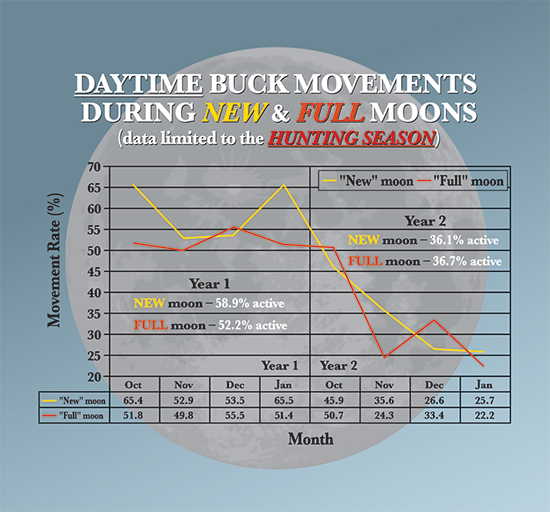
Every year, we read articles on the relationship between deer movements and specific phases of the moon. Various charts and tables are published, which include the latest truths or “scientific” links between maximizing your days afield to the different phases of the moon (new, waning, waxing, and full).
But, is there any science to these claims?
One of the first to make a connection between moon phase and deer movement was the late Jeff Murray, who in 1992 created the Moon Guide. Jeff and I spent many hours discussing his guide. In short, it picked the best days, times, and locations for hunters. Depending on whether the moon is directly above or below the Earth, the Moon Guide tells you whether your time afield should be spent near bedding, feeding, or transition zones.
The problem is, deer are constantly changing bedding and feeding areas, sometimes on a daily basis. For example, it’s not unusual for a deer to have over three different bedding areas within a 24-hour period.
Even with today’s GPS collar technology, it’s difficult to determine a deer’s bedding or feeding areas. These areas can be very dynamic, so how can a hunter rely on his own limited observations, even with the aid of ample trail cameras? Answer: It’s very difficult. In fact, with the advent of radio-telemetry technology, biologists quickly realized many of our previous observation data were completely wrong. Still, there are accomplished hunters who still swear by and base their hunting schedule on moon guides, or other claims to the various phases of the moon.
Years ago, whenever I needed any advice on deer, I want to the “source.” And for me, that meant Pap. Although he had no biological training, he was the authority on any hunting-related question. His answers were based on hard-core experience from the woods, and that meant deer would move more at night during full-moon events than during the day. Therefore, all-day hunts during full-moon events were primarily only experienced during the rut.
Chances are you can relate to this advice, but is it true? One of the first trail-camera studies on deer movement occurred back in the 1990s. The results concluded there were no significant differences between moon phase and deer movement. But this trail-camera study, and many others like it, are biased. Why? Because of the effect of bait, for example corn. The reason being, deer could be coming to a bait site more often, if no bait was present.

A more recent study was conducted by Dr. Mickey Hellickson at the King Ranch in South Texas. Hellickson used GPS collars on 43 bucks, and he collected over 42,000 data points by using activity monitors. After two years of work from October to January, he determined peak activity occurred between 7 a.m.-9 a.m., and 6 p.m.-7 p.m. And, even with this massive data set, it showed no difference in buck movement between a new (dark) or full moon. Hellickson concluded, “Although the moon may influence buck movements in other ways, our data did not indicate any patterns relative to the effects of moon phase on buck movements.”
While conducting his graduate work at North Carolina State, Dr. Marcus Lashley compared over 22,000 GPS locations to moon phase. Like Hellickson, Lashley concluded deer are primarily crepuscular, regardless of moon phase. He also compared solunar tables to his data set, and found they were only 25-percent accurate. Although not significant, he found midday movements tended to be greatest during the full moon. But remember, Lashley’s data set was only slightly varied from one phase to the next.
Another study in Pennsylvania showed does moved 20 feet more per hour during a new moon versus a full moon during the October timeframe. Are these few steps significant? I don’t think so. This study showed does moved 200 feet per hour at night, and 165 feet per hour during the day. As you’d expect, they moved the most at sunrise and sunset, nearly 450 feet per hour.
In conclusion, if a hunter takes a 200-inch buck during a full moon, is there really anything anyone can say to convince him the moon doesn’t have an effect on deer movement? Maybe not? Biologists Dr. James C. Kroll and Ben Koerth may have summed up the moon phase as it relates to deer movement best when they wrote in their book, “Solving the Mystery of Deer Movements,” “Because the moon is such a noticeable phenomenon in our world…it seems almost intuitive it must have equally profound effects on the habits and lifestyle of animals as well, at least we all want to believe it to be so.”
C.J.’s Summary: Hunters are always looking for a shortcut to maximize their success and time in a stand. GPS data from current biological sources is clear. There is no relationship between moon phase and deer movement. The bottom line is: Moon phase is irrelevant in the day to day nutritional or survival requirements of a deer. Yet, there are hunters who will adamantly argue over the data. If you are one of them, so be it. As a hunter, I’d suggest you keep doing what has been working for you. But, keep in mind, all deer are individuals. What makes one deer get up and move versus another, is likely a completely different environmental scenario. And, just because a specific moon phase worked on a giant buck years ago (and you still remember), doesn’t mean it will work on another buck.
Although it may be hard to digest, the best moon tip is to completely ignore all the moon-phase fallacies. Additionally, hunting no more than two times per week in the same stand is highly recommended. In short, there’s simply no better advice than to wisely put in your time in your favorite stand. As for me, if the moon in all its various phases is still orbiting the earth…it’s time to hunt.











































